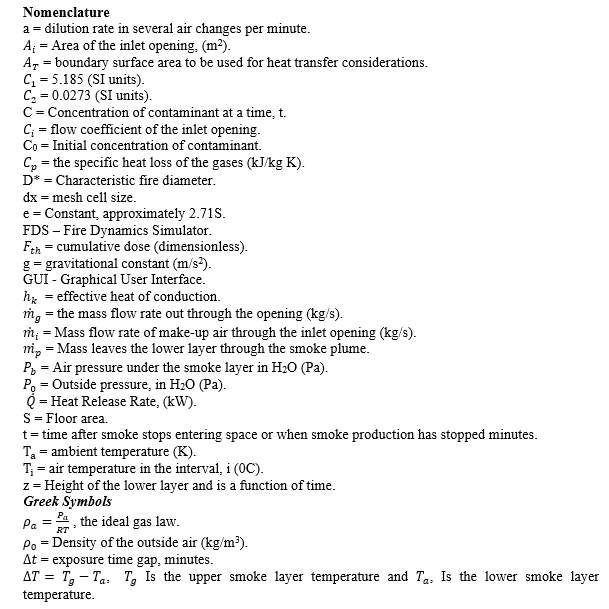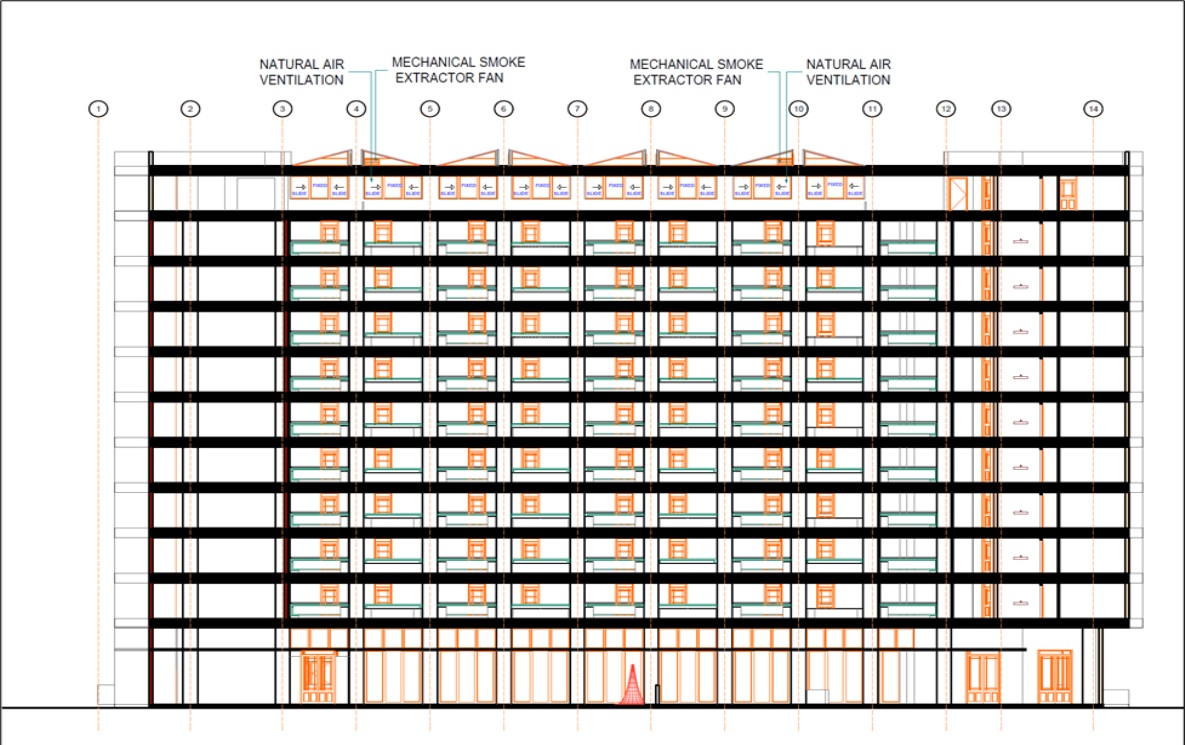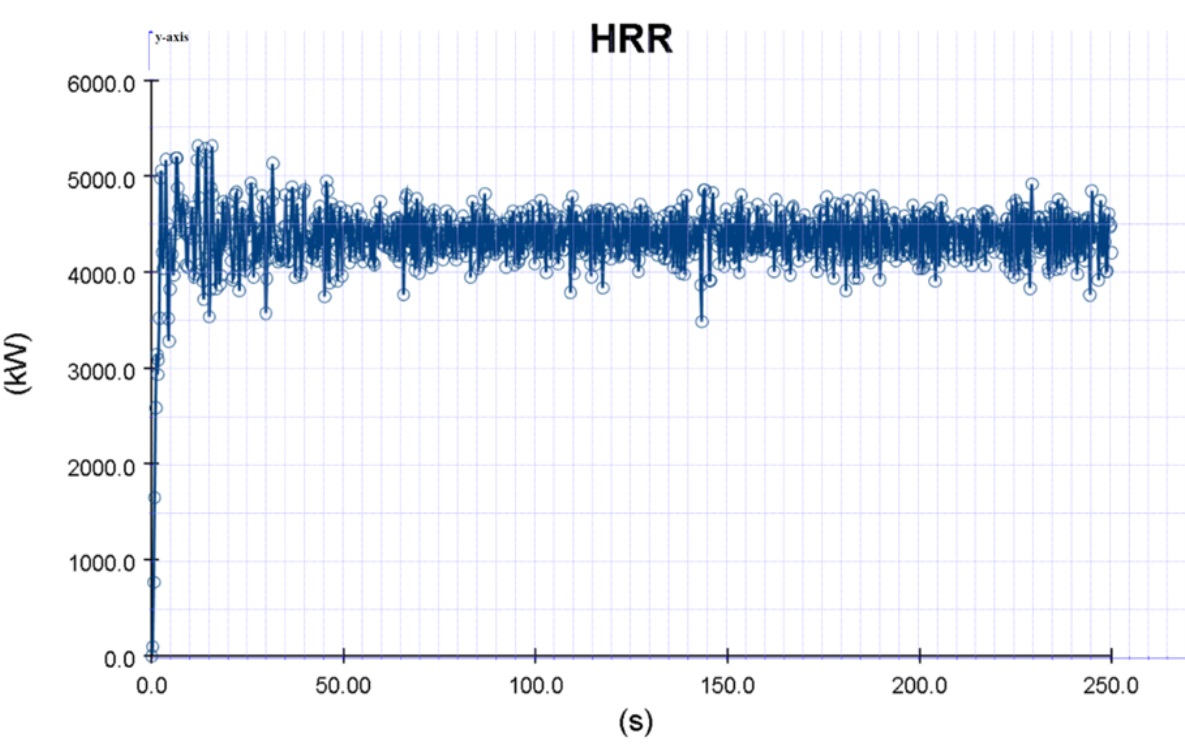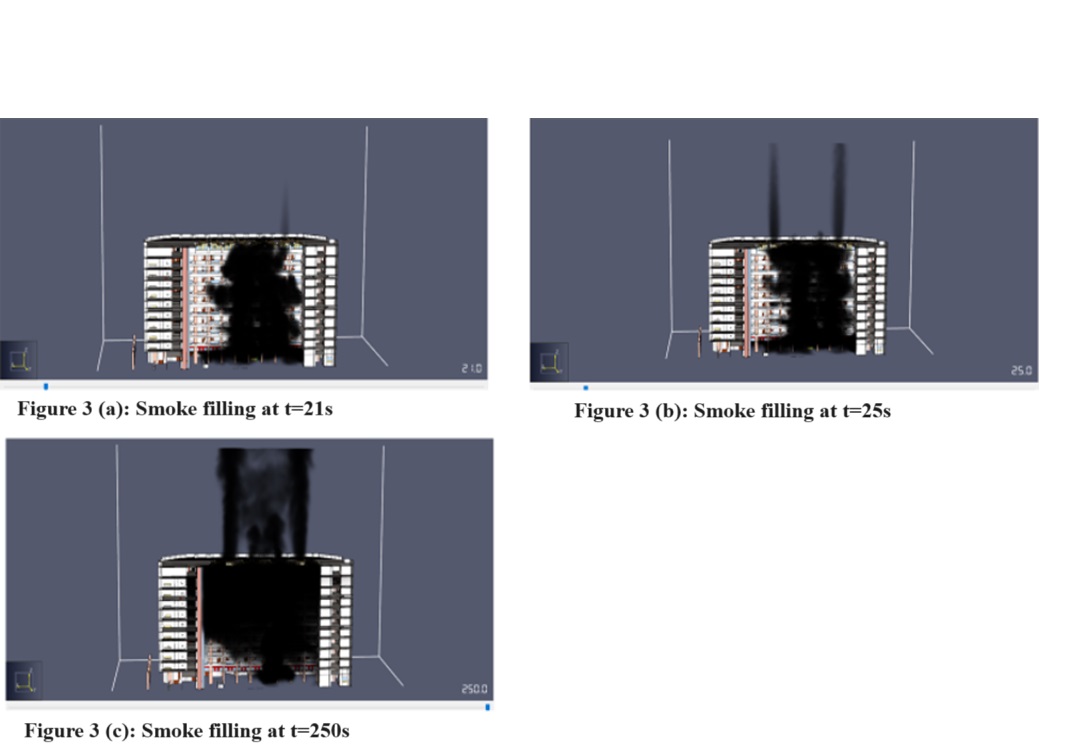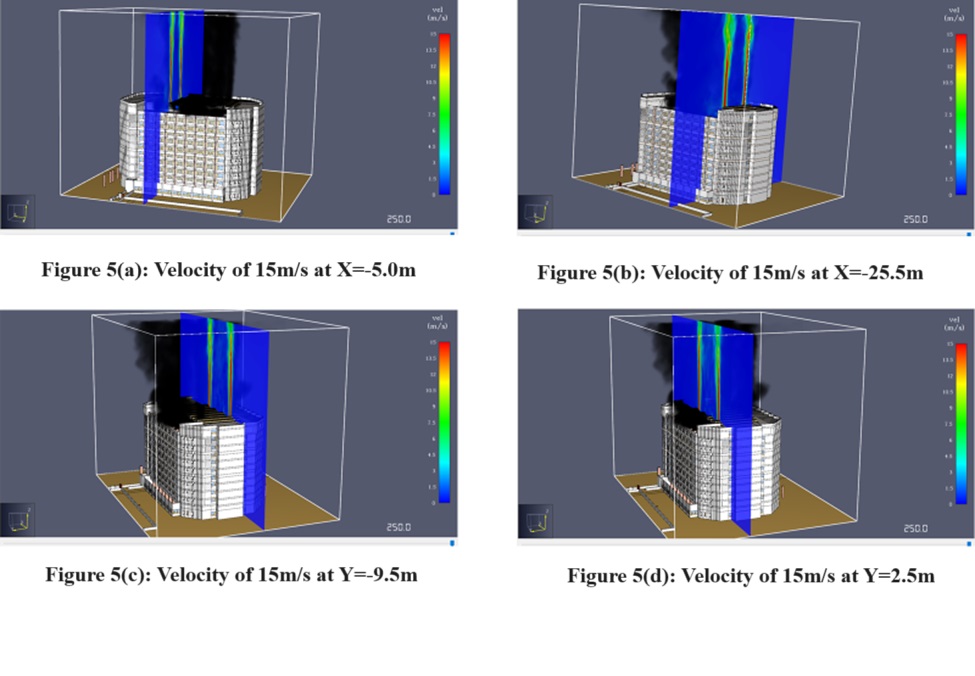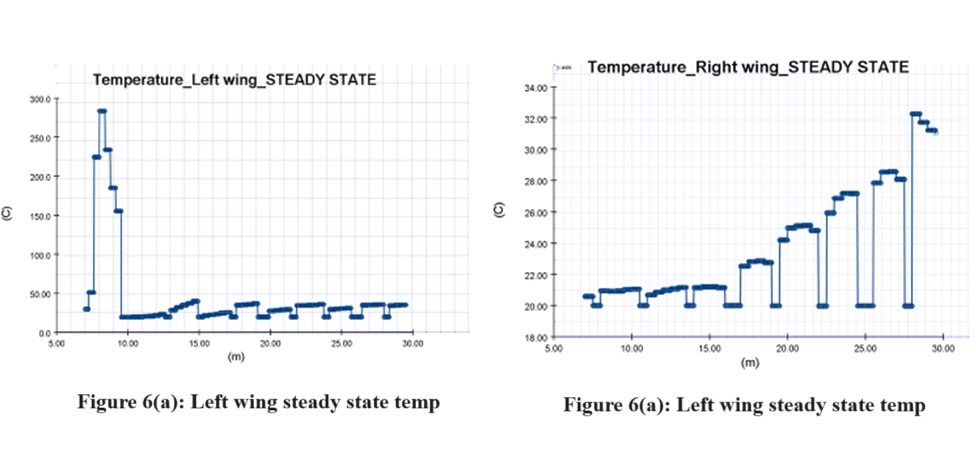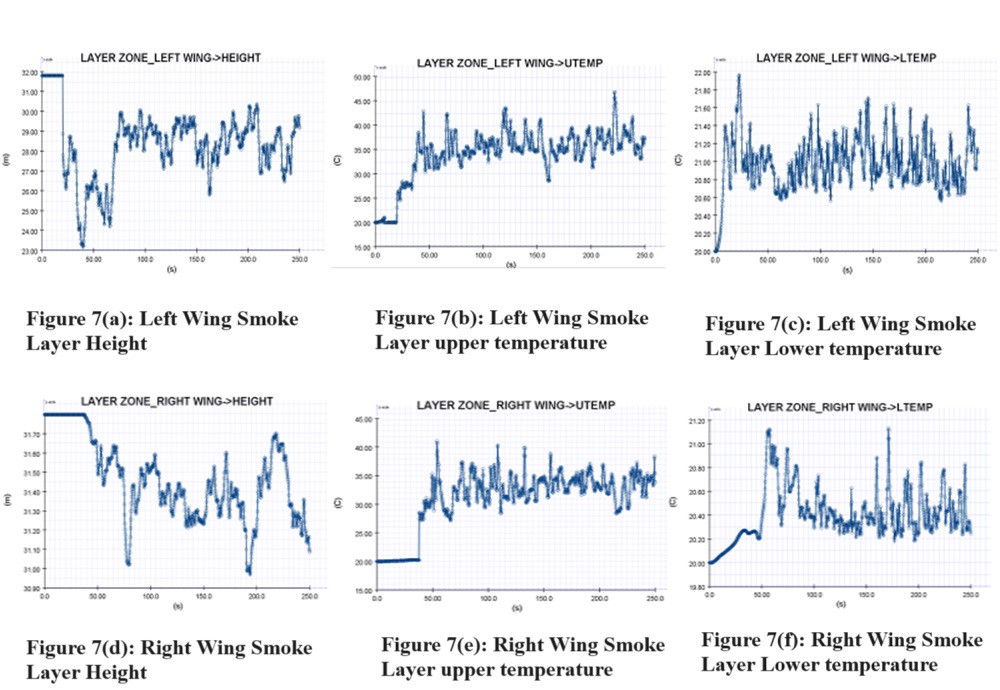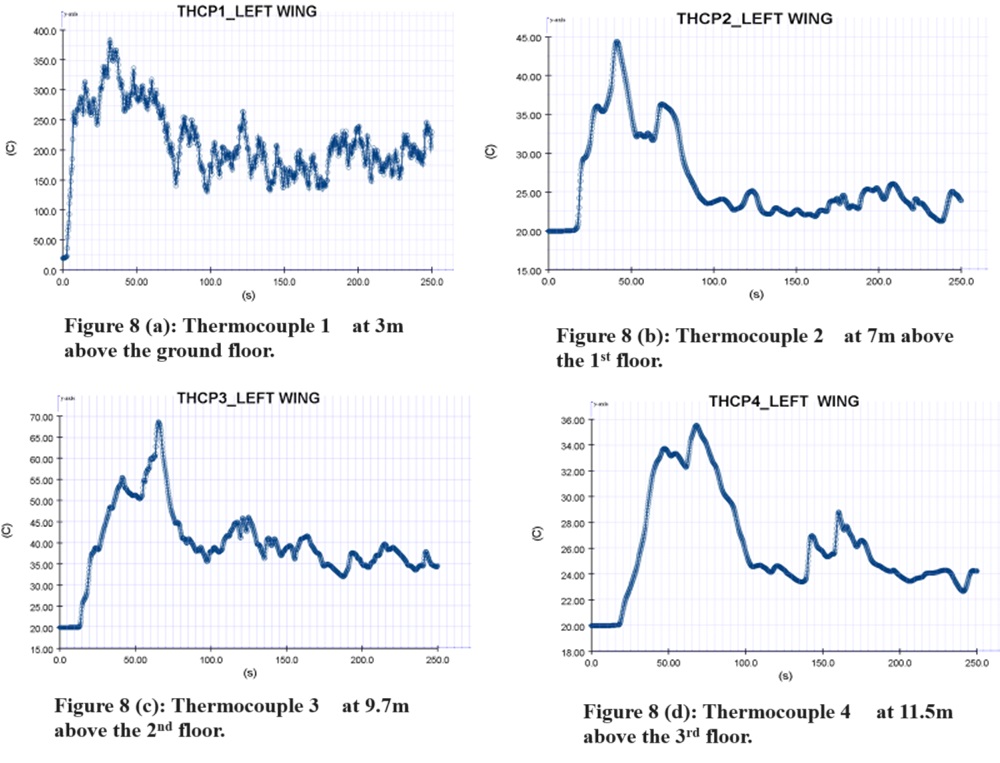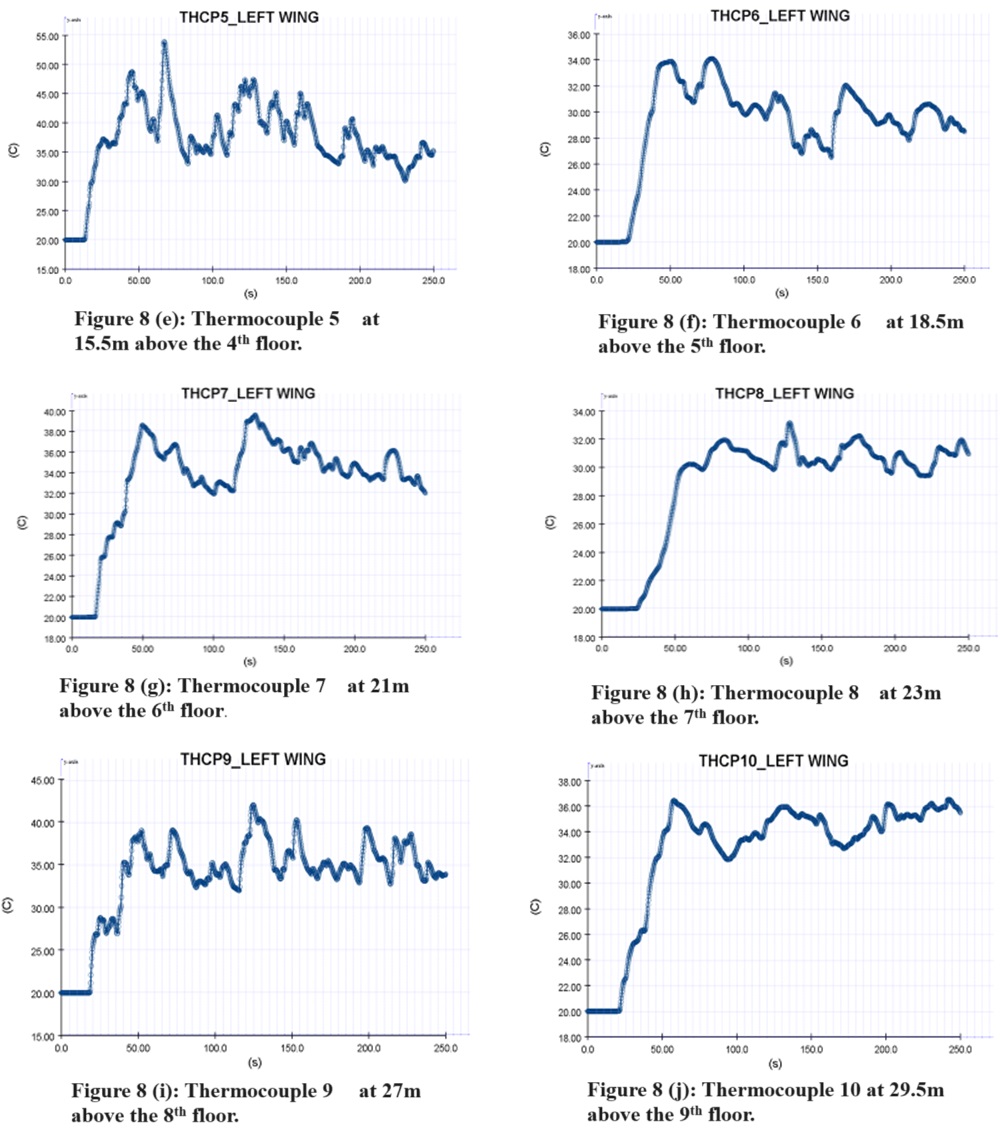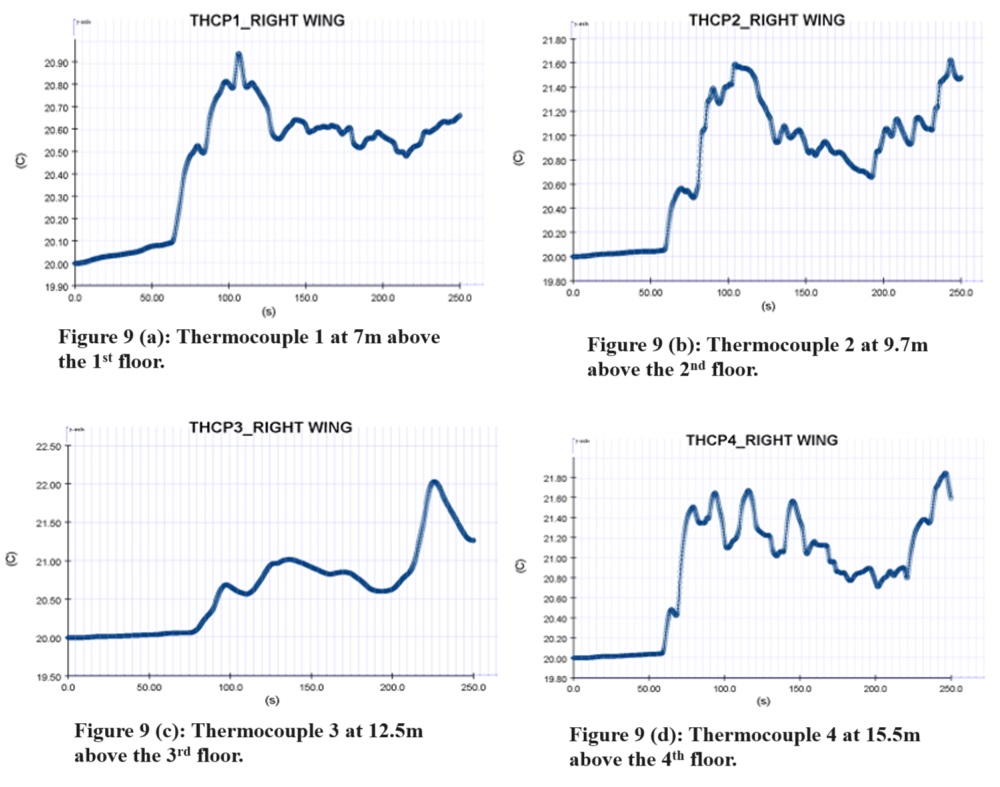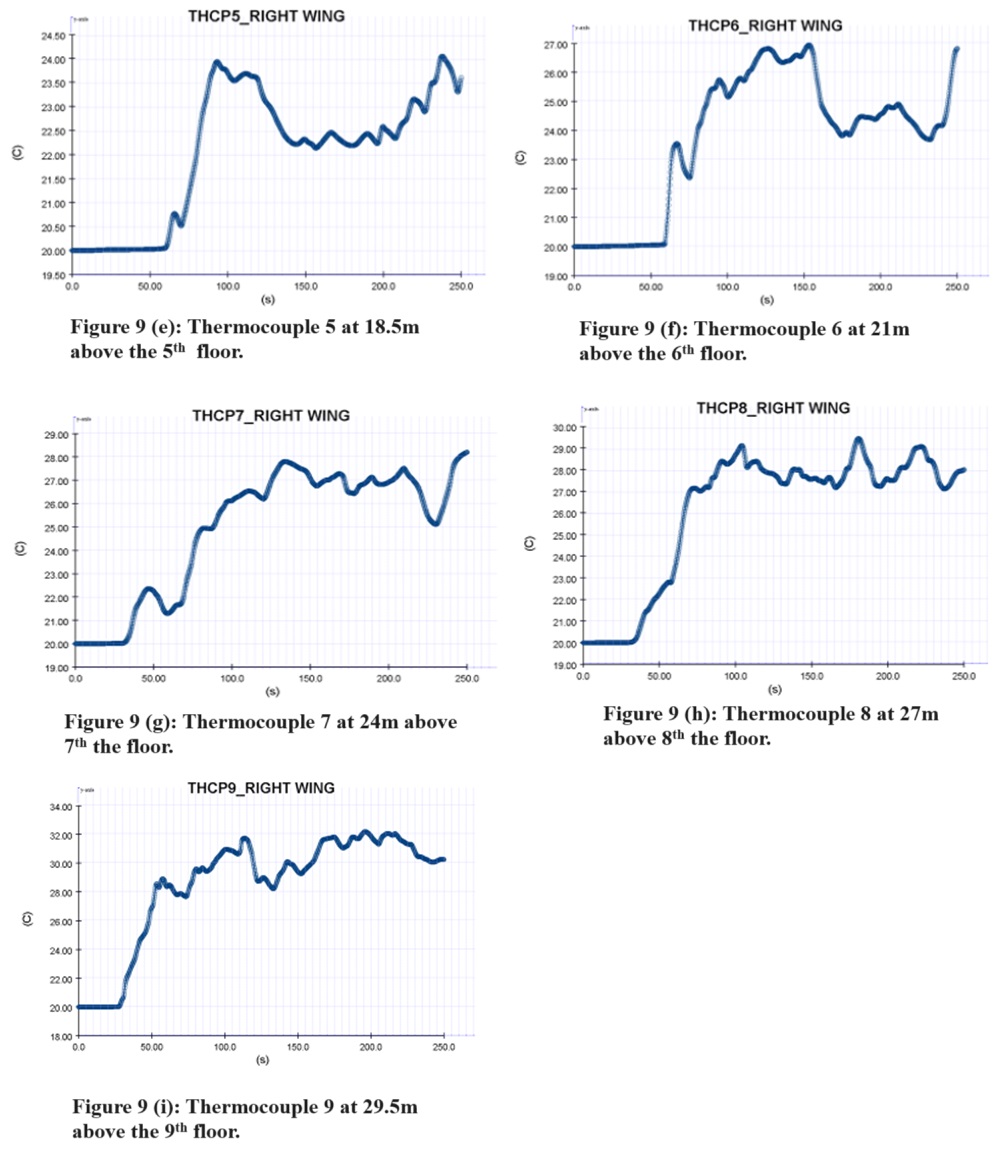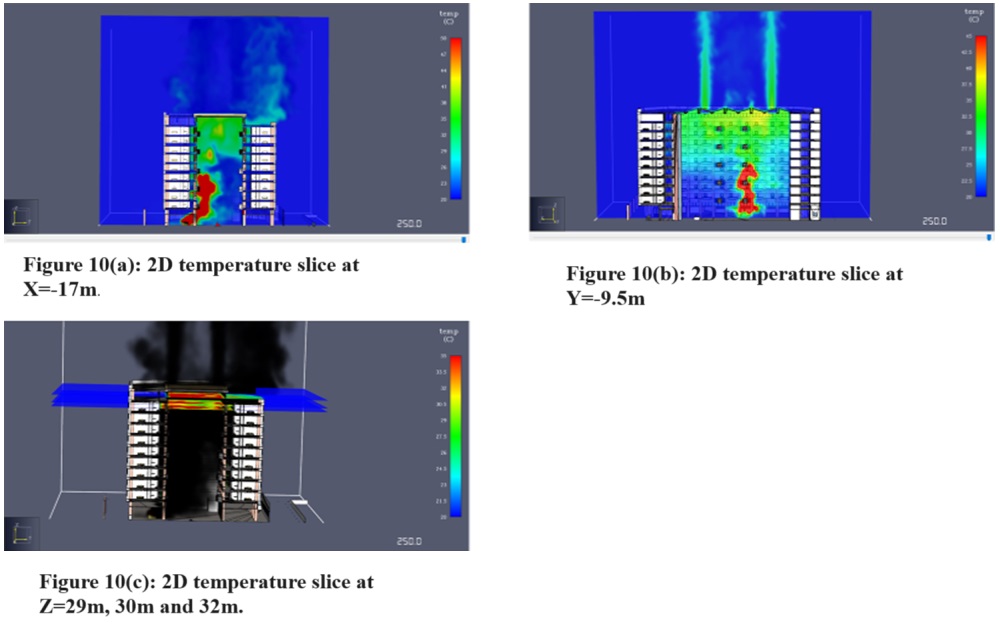Performance-Based Design Assessment of Temperature Tenability Condition in a Hotel Atrium
- John Reuben Kisilu
- Dr Ernest Odhiambo (Ph.D)
- Dr Reuben Mwanza Kivindu (Ph.D)
- 460-474
- Apr 10, 2024
- Architecture
Performance-Based Design Assessment of Temperature Tenability Condition in a Hotel Atrium
John Reuben Kisilu1, Dr Ernest Odhiambo (PhD)2, Dr Reuben Mwanza Kivindu (PhD)3
1 MSc Student, Department of Mechanical and Manufacturing Engineering, University of Nairobi
2 Department of Mechanical and Manufacturing Engineering, University of Nairobi
3Department of Mechanical and Manufacturing Engineering, University of Nairobi
DOI: https://doi.org/10.51244/IJRSI.2024.1103033
Received: 24 February 2024; Revised: 06 March 2024; Accepted: 11 March 2024; Published: 10 April 2024
ABSTRACT
Fire safety risk assessment to prevent loss of human life and property is necessary for complex structures where the traditional prescriptive designs are inapplicable. Maintaining tenable temperature conditions is essential for the safe evacuation of building occupants. This study considered British Standards (BS) 7974 and the Code of Practice for Fire Precautions in Buildings to analyze the temperature tenability conditions in the hotel atrium through a performance-based design approach. Further, the Computational Fluid Dynamics (CFD) code, Pyrosim, a Graphical User Interface (GUI) of the Fire Dynamics Simulator (FDS), was utilized to simulate a constant Heat Release Rate (HRR) steady state design fire of 5 Megawatts (MW) igniting from the hotel brasserie (ground floor) within the atrium. The researcher used the big design fire of 5MW to generalize the results to similar fires in similar structures. The objective was to conduct a fire safety risk assessment to prevent loss of property and fatalities by activating a smoke management control system with a ‘what if’ condition when the fire suppression system failed to start. Temperature data was collected through the statistical steady state profile, smoke layer temperatures, thermocouples, and 2-dimensional slice temperature recordings. The ground floor, the fire source, was found to have untenable conditions for human survival with temperatures above 2250C, as confirmed by thermocouple and steady-state temperature profile readings. Other floors demonstrated tenable conditions for human survival with temperatures below 400C due to the effect of natural vents and mechanical extractors, which extracted the hot smoke at a rate of 15m/s. The temperature recordings from this study compared well with those from Chew and Liew’s (2000) Computational Fluid Dynamics results, which had fire igniting within the atrium, without sprinklers, and had mechanical extraction fans and a constant Heat Release Rate of 5 Megawatts (MW). The results indicated that the smoke control management system maintained tenable temperature conditions within the hotel atrium, even without the fire suppression system through sprinklers. Considering the design fire size was 5 MW, which was significantly big, the results could be generalized for other hotels or structures with similar designs.
Keywords: Fire Hazard, Risk Assessment, Fire Safety, Tenability conditions,
INTRODUCTION
Risk assessment of fire hazards in complex building structures with multiple installations like cookhouse facilities for food processing and Heat Ventilation Air Conditioning (HVAC) for maintaining ambient temperature for the building occupants is problematic. Fire safety engineering, or performance-based design, is concerned with designing fire smoke control regimes for complex building structures (CIBSE, 2010). The British Standard, BS 7974 (British Standards Institution, 2001), is a framework for applying fire safety engineering principles. The performance-based design is an excellent alternative to prescriptive design approaches to enhance safety by preventing loss and mitigating the fire outbreak’s impact. The methods available in performance-based plans are comparative, deterministic, and probabilistic approaches (CIBSE, 2010).
This study adopted a deterministic approach in the fire risk assessment, in which a designed fire scenario should reflect the ‘worst credible case.’ The primary consideration was the fire hazard location, severity, and smoke generation potential (CIBSE, 2010). The deterministic risk assessment approach is suitable in this case study because the hotel has a height of 33.9m with multiple cascading balconies towards the atrium ceiling. The method is best suited to scenarios involving fire, smoke spread, and simulated scenarios testing the performances of the various smoke management systems. The fire scenario selected had fire igniting in a hotel atrium brasserie, which inherently had a chance of fire outbreak during the heating up of the hotel space to keep hotel occupants comfortable. An assumption was made that the sprinkler system failed to activate, but the natural vents and mechanical extraction fans started as designed. The fire and smoke spread were mitigated by exhausting the hot smoke through the natural vents and mechanical extraction fans. The simulation analysis evaluated the fire safety risk assessment of the building’s inherent safety design of the fire safety and prevention system. The evaluation was done by determining the temperature tenability conditions in the hotel atrium through the exhaust of the hot smoke. The ultimate objective was loss prevention to human lives and property.
The atrium is a space that is aesthetically designed to provide a large glazed aura to provide sunlight to the building occupants while socializing in the sitting spaces within the building. The design enhances air circulation and communication between different building floors. It has been a popular design since ancient Mesopotamia (Moosavi et al., 2014). The hotel atrium under study had a volume of 18,496m3. It is recommended that a hotel atrium should not exceed a volume of 28,000m3 (Fire Safety Bureau, 1997).
Tenability Analysis assessed the risk of prolonged exposure to enhanced doses of elevated Temperature, Visibility, and Toxicity conditions (Tustin et al., 2018). The view was to evaluate the adequacy of the existing fire safety and protection systems in preventing and mitigating the occurrence of fatalities. The human body is designated to operate within a narrow range of temperature variations at about 370C degrees in which the homeostatic processes are optimal – high-temperature conditions may lead to heat stress with fatal consequences (Lucas et al., 2014). A temperature range between 370C and 400C brings about milder effects of heat exhaustion, while temperatures beyond 400C may lead to central nervous dysfunction (hyperthermia/heat stroke) (Gopinath, 2018). Exposure to extreme temperatures could lead to skin burns. The rule of thumb is to use a threshold of about 1210C for dry air to determine which of the two conditions prevailed. For Temperatures less than 1210C, the human body experiences hyperthermia and skin burns for temperatures exceeding 1210C. Mathematically, the temperature that could cause hyperthermia or heat stroke can be estimated from the equation (Klote & Milke, 2002);
(1)
This study utilized a design fire that was steady for idealization and getting conservative results (Klote & Milke, 2002). A 5MW design fire with a Constant Heat Release Rate (HRR) was chosen to be simulated in a scenario with natural vents and mechanical extraction fans expunging the hot smoke from the hotel atrium. Thus, the smoke filling was steady with leakage at the ceiling through the natural vents and mechanical extraction fans. This scenario could be explained by the conservation of mass equation (Karlsson & Quintiere, 1999);
(2)
This scenario, with a known Heat Release Rate, (kW), could be explained that the smoke layer temperature increased from the ambient temperature by the expression below (Karlsson & Quintiere, 1999);
(3)
Further, the known Heat Release Rate, (kW), was used to determine the characteristic fire Diameter, D* expressed as (McGrattan et al., 2007; US Nuclear Regulatory Commission, 2007);
(4)
The mesh size, dx, was set at 0.3665m. The dx, which was used in this simulation, was 5.
MATERIAL AND METHODS
BS 7974 recommended a Qualitative Design Review (QDR) (British Standards Institution, 2001) to model fire and smoke spread scenarios. The CFD simulation was done to test the system failure through the ‘what if’ fire safety risk assessment. Therefore, the simulation conducted the hotel atrium fire and smoke safety risk assessment, assuming that the atrium sprinklers failed due to poor maintenance (CIBSE, 2010). In this case, performance-based designs should always consider the impact of the fire suppression system failure and whether the smoke control management system would adequately detect the fire hazard and prevent the loss of human lives and property.
The hotel had an atrium with a height of 33.9m. The fire was set to ignite at the brasserie(ground floor). The natural vents were found on the sunglass roof. The top part of the roof had twenty-four (24) vents measuring 823mm x 914mm. The vents were mounted on eight (8) overlapping roofs along the X-section, each with three (3) vents. The vents formed part of an array of natural vents on the sunglass roof.
In contrast, other natural vents and mechanical extractors were mounted along the Y-section on the sunglass roof. The automatic smoke extraction vents aim to create tenable conditions for the hotel occupants to escape by exhausting the hot smoke and preventing the smoke layer from dropping. The four mechanical extraction fans were located along the Y-section. The rating of the mechanical extraction fans was 40m3/s. The location of the natural vents and mechanical extraction fans is shown in Figure 1 below.
Figure 1: Schematic representation of the hotel’s natural vents and mechanical extraction fans.
This study used Pyrosim, the Graphical User Interface (GUI) of the Fire Dynamics Simulator (FDS) (Klote et al., 2012). In the study, the simulation utilized uniform mesh to simplify the complexity of the simulation setup. The study was anchored on a domain height of up to 70m and a cell grid size of 0.3665m x 0.3665m x 0.3665m with 2,565,512 cells. The simulation period was 250s. The setup included 2D slices for gas phase quantities of Temperature and Velocity. A layer zoning device determined the smoke layer height and upper and lower temperatures for the hot smoke. Thermocouples were set at selected heights from the atrium floor to record temperature variations as the smoke rose toward the atrium ceiling. Additional temperature recordings were taken through statistical devices.
The study was compared with the experiment conducted by Chew and Liew (2000) on Smoke Movement in Atrium Buildings, which exhibited nearly identical features. The setup comprised a 30m height, eight mechanical extraction fans capable of 20m3/s, a simulation duration of 240s, a Constant Heat Release Rate (HRR) set at 5MW and lacked sprinklers. The setup used the CFD PHOENICS code (Chew & Liew, 2000). This study was chosen to benchmark the findings for the current research.
RESULTS AND DISCUSSIONS
This study adopted temperature tenability criteria with the maximum tolerable temperatures and duration for the building occupants, as shown in Table 1 (Klote, 1999):
Table 1: Time for Incapacitation due to exposure to elevated temperature.
| Temperature (0C) | 40 | 50 | 60 | 70 | 80 | 90 |
| Time for incapacitation (min) | 60 | 46 | 35 | 26 | 20 | 15 |
Further, the CFD results for the experiment by Chew and Liew (2000) were evaluated against the above criteria. The simulation results from Chew and Liew (2000) indicated that the temperature in the atrium and smoke reservoir was 670C to 900C. The 1st to 5th floor also had a temperature range between 230C and 430C. The temperature results from the study were considered to be within acceptable limits (Chew & Liew, 2000).
Figure 2 shows the results of a 5MW design fire with a Heat Release Rate Per Unit Area (HRRPUA) of 1250kW/m2. The simulation results indicated that the HRR was maintained between 4000-5000kW throughout the simulation period.
Figure 2: Constant HRR for 5MW fire source.
The mechanical smoke extraction was activated at t=21s, as shown in Figure 3(a), and continued to pick, as indicated in Figure 3(b), up to t=250s when it was fully functioning. Figure 3(c) also shows a situation when the natural vents were fully functional. Mechanical smoke extraction is a situation of smoke dilution, also called smoke purging, smoke removal, smoke exhaust, or smoke extraction. The dilution rate for a problem when the fire is extinguished can be given by the equation below (Klote & Milke, 2002);
(5)
Figures 4 (a) and (b) show the make-up air mixing with the hot smoke and being exhausted from the atrium. The make-up air is through a natural vent at the atrium entrance. The make-up air is cold and enters at a velocity of 1m/s and dilutes the temperature of the hot smoke. The equation gives the mass flow of make-up air at the inlet (Klote & Milke, 2002);
(6)
Figure 4(a): Makeup air at t =10s Figure 4(b): Makeup air at t = 250s
Figures 5 (a), (b), (c), and (d) show the mechanical extraction fans at X and Y planes exhausting the hot smoke from the hotel atrium at a velocity of 15 m/s and t=250s. The combined entry of the cold make-up air and the exhausting of the hot smoke has the effect of maintaining tenable Temperature conditions within the hotel atrium.
The statistical steady-state temperature readings represented the ideal temperature status within the atrium plotted for the left and right wings, as shown in Figures 6(a) and (b). Close to the fire source on the left wing of the atrium, the temperature was as high at almost 3000C. However, the temperature was as low as 400C when the hot smoke exited the atrium. The temperature on the right wing was 200C near the floor. It heated up to 320C by the time the smoke exited the atrium.
Smoke Layer Analysis was conducted to determine the Smoke Layer Height and the Smoke Layer Temperatures. Figure 7(a) indicated that the Smoke Layer on the left wing of the atrium dropped to a depth of 9m. The smoke layer drop was assessed to cover the 7th, 8th, and 9th floors on the left wing of the atrium. However, from the 40th minute, the smoke layer depth was reduced to 3m, covering only the 9th floor. The reduction in smoke layer depth could be attributed to the action of natural vents and mechanical extraction fans. The Upper Smoke Layer Temperature stabilized at 350C while the Lower Smoke Layer was maintained at 210C, as shown in Figures 7 (b) and 7 (c). The Smoke Layer characteristics on the right wing of the atrium, as shown in Figure 7(d), experienced negligible effects. The Smoke Layer depth of 1m on the right wing of the atrium indicated that the 9th floor had a limited Concentration of smoke, the Upper Smoke Layer temperature was 350C, and the Lower Smoke Layer Temperature was 200C, as shown in Figure 7(e) and (f) respectively.
The study analyzed the temperature conditions per floor on the left wing of the atrium as per thermocouple readings. The thermocouple, shown in Figure 8(a), experienced a maximum temperature of about 4000C. The temperature recorded by the thermocouple stabilized at 2250C on the ground floor for the rest of the simulation period at the t=50s. The 1st floor, shielded by the hotel balcony, experienced a maximum temperature of 450C within the first 100s after the fire ignition and later stabilized at 250C during the rest of the simulation period, as indicated in Figure 8(b). Presumably, the smoke extraction had a cooling effect experienced on this floor. Figure 8(c) shows the thermocouple indicating that the 2nd floor experienced a maximum temperature of 700C within the first 85s. The temperature stabilized at 350C during the rest of the simulation period. The 3rd floor registered a maximum temperature of 350C within the first 70s since the fire ignition and later stabilized at room temperature during the simulation period, as shown in Figure 8(d). The 4th floor experienced a maximum of 540C within the first 70s of the ignition of the fire. It later stabilized at 350C during the rest of the simulation period, as indicated in Figure 8(e). The 5th floor experienced a maximum temperature of 340C during the 50s of the ignition of the fire. It stabilized at 290C during the rest of the simulation period, as tabulated in Figure 8(f). Figure 8(g) shows that the 6th floor experienced a maximum temperature of 390C at the 50th second, which later stabilized at 320C. The 7th floor experienced a constant temperature of 320C, as Figure 8(h) indicates. The 8th floor experienced a maximum temperature of 400C at the 50th second, oscillating about 350C for the rest of the simulation period, as shown in Figure 8(i). The 9th floor experienced a sustained temperature of 360C at the 50th second, as shown in Figure 8(j). Generally, the left wing of the atrium experienced tenable temperature conditions, save for the brasserie (groung floor) that was the fire’s source. The brasserie(ground floor) experienced a maximum temperature of 4000C, with a stabilized temperature of 2250C at the 50th second. The temperature at the brasserie(ground floor) was untenable for human survival.
Thermocouple readings on the right wing of the atrium, as indicated in Figure 9(a), show that 1st floor experienced average temperature ranges within 200C. Additionally, the 2nd floor, as shown in Figure 9(b), 3rd floor, as indicated in Figure 9(c), 4th floor, as tabulated in Figure 9(d), 5th floor, as shown in Figure 9(e), 6th floor, as illustrated by Figure 9(f) and 7th floor, as indicated by Figure 9(g) experienced maximum temperature ranges of 200C, 210C, 220C, 220C, 240C, 270C and 28℃, respectively. Further, the 8th and 9th floors experienced maximum temperature ranges of 29℃ and 32℃, as shown in Figures 9 (h) and (i). The thermocouple readings from the temperature on the right wing of the atrium indicate that the temperature conditions are tenable for human survival.
Figure 10(a) shows that the 2D temperature slice at X=-17m on the fire source recorded the highest temperature. It indicates that the maximum temperature experienced within the atrium was about 500C. However, on the balcony space on the left wing of the atrium, the temperature was 350C. For the right wing of the atrium, the temperature was well below 230C. The Y-Plane at Y = -9.5m, as indicated in Figure 10(b), shows that the temperatures on the left wing ranged between 200C and 37.50C. Figure 10(c) suggests that the Z-Plane at Z=29m, 30m, and 32m on the 9th floor indicated that the maximum temperature experienced was 350C. The 9th floor experienced the worst smoke density and maintained the smoke layer height even after the smoke was expunging by the smoke extraction fans.
CONCLUSION
Exposure to prolonged elevated temperatures can result in Heat Stroke (Hyperthermia), often manifesting as confusion and collapse during fire incidents. This simulation used a relatively big design fire of 5 MW to enable the generalization of the findings to suit designs incorporating mechanical extraction fans and natural ventilation vents. The study used statistical temperature profiles, smoke layers, and thermocouples to obtain comparative temperature readings in the atrium. Activation of mechanical extraction fans occurred at t=21 seconds following the fire’s initiation, while natural vents were activated at t=25 seconds. Maximum temperature was observed at the ground floor, the fire’s origin, reaching 400°C and stabilizing at 225°C by the 50th second, as per the thermocouple readings, and 3000C as recorded by the statistical steady state temperature profile, coinciding with the influence of the natural vents and mechanical extraction fans extracting smoke at the rate of 15m/s. This shows that the ground floor had temperatures that were untenable for human survival at the ground floor. However, the subsequent floors experienced tenable temperatures below 40°C, attributed to smoke purging facilitated by natural vents and mechanical extraction fans.
The simulated ‘what if’ fire safety risk assessment of the smoke management control system demonstrated a mitigated loss prevention scenario in the event of sprinkler system failure. Consequently, the fire safety risk assessment indicates that, except for the ground floor of the left wing of the atrium with extreme temperatures, the remainder of the hotel atrium maintained tenable temperature conditions conducive to occupant escape and rescue. Thus, the smoke management control systems of natural vents and mechanical extraction fans effectively mitigate the risk of fire fatalities and subsequent loss of hotel property. These results can be generalized for any building with similar design and fittings.
FUNDING
This research was funded by the Kenya Defence Forces (KDF) through Defence Forces Technical College (DEFTEC), a College of National Defence University-Kenya.
ACKNOWLEDGMENTS
I acknowledge the financial and material support from the Kenya Defence Force (KDF) through Defence Forces Technical College (DEFTEC), a College of National Defence University-Kenya, which made this research possible. I also recognize the guidance from Dr. Ernest Odhiambo (Ph.D.) and Dr. Reuben Mwanza Kivindu (Ph.D.) in making this paper a substantive piece worth reading.
REFERENCES
- British Standards Institution. (2001). 7974 Application of Fire Safety Engineering Principles to the Design of Buildings-Code of Practice. London, UK: British Standards Institution.
- Chew, M. Y. L., & Liew, P. H. (2000). Smoke movement in atrium buildings. International Journal on Engineering Performance-Based Fire Codes, 2(2), 68-76
- CIBSE. (2010). Guide E: Fire safety engineering (3rd Edition). London: Chartered Institution of Building Services Engineers.
- Fire Safety Bureau. (1997). Code of Practice for Fire Precautions in Buildings. Singapore: Singapore Civil Defence Force.
- Gopinath, K. G. (2018). Heat stroke and heat exhaustion: An update. Current Medical Issues, 16(1), 5-9. doi:10.4103/cmi.cmi_12_18
- Karlsson, B., & Quintiere, J. (1999). Enclosure Fire Dynamics (1st ed.). CRC Press
- Klote, J. H., & Milke, J. A. (2002). Principles of Smoke Management. Atlanta: ASHRAE.
- Klote, J. H., Milke, J. A., Turnbull, P. G., Kashef, A., & Ferreira, M. J. (2012). Handbook of Smoke Control Engineering. Atlanta: ASHRAE
- Klote, J.H. (1999). An Engineering Approach to Tenability Systems for Atrium Smoke Management. ASHRAE Transactions CD, proceedings of the 1999 ASHRAE Winter Meeting, held Chicago, USA.
- Lucas, R. A., Epstein, Y., & Kjellstrom, T. (2014). Excessive occupational heat exposure: a significant ergonomic challenge and health risk for current and future workers. Extreme Physiology & Medicine, 3, 1-8. doi:10.1186/2046-7648-3-14
- McGrattan, K., McDermott, R., Hostikka, S., & Floyd, J. (2007). Fire Dynamics Simulator (Version 5): User’s Guide. National Institute of Standards and Technology, Gaithersburg, MD
- Moosavi, L., Mahyuddin, N., Ab Ghafar, N., & Azzam Ismail, M. (2014). Thermal performance of atria: An overview of natural ventilation effective designs. Renewable and Sustainable Energy Reviews, 34, 654-670. doi:10.1016/j.rser.2014.02.035
- Tustin, A. W., Lamson, G. E., Jacklitsch, B. L., Thomas, R. J., Arbury, S. B., Cannon, D. L., … & Hodgson, M. J. (2018). Evaluation of occupational exposure limits for heat stress in outdoor workers—United States, 2011–2016. Morbidity and Mortality Weekly Report, 67(26), 733-737. doi:10.15585/mmwr.mm6726a1
- US Nuclear Regulatory Commission. (2007). Verification and Validation of Selected Fire Models for Nuclear Power Plant ApplicationsNUREG-1824

